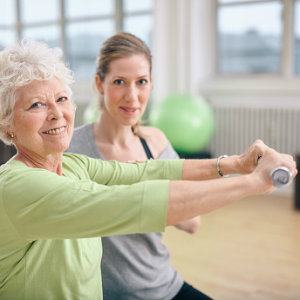Your goal is to remain active and independent, and a Harvard publication is calling flexibility the “secret sauce” to continuing to move safely and easily — which is a key component in enjoying your independent lifestyle. A crucial element of staying flexible? Stretching!
Flexibility declines because muscles stiffen. If not stretched, they will eventually shorten, and shortened muscles don’t contract as well. And when you use shortened muscles, you can damage them and also experience joint pain. Shortened muscles also increase your risk of falling, and it can be harder to climb stairs or reach for items.
When you stretch, you are extending your muscles and, if that position is held for an adequate amount of time, the muscle will remain elongated post-stretching. Stretch often enough and you can, as stated in the article:
- Increase your range of motion
- Reduce your risk for muscle and joint injury
- Reduce joint and back pain
- Improve your balance, thus reducing your risk of falling
- Improve your posture
Ready to improve your flexibility? After checking with your doctor, begin a stretching program with the goal being muscle stretching at least three or four times weekly — daily if possible. Flexibility won’t magically be restored, the article cautions, but persistence will produce results.
Exercises to Increase Flexibility for Older Adults
Warm up muscles first to get them needed blood and oxygen, which makes them more pliable. Consider doing two to five minutes of dynamic stretching, which involves repeatedly moving a joint through its range of motion, without holding a stretch in a static position. Stop stretching whenever you feel pain, defined as “beyond a mild burning sensation.”
The Harvard article shares six specific stretches that you should consider. Here is one of them, the seated shoulder stretch. This should be repeated two to four times, with each stretch held 10 to 30 seconds. With this stretch, you sit up straight in a chair and then place your left hand on your right shoulder while cupping your left elbow with the right hand. The article provides an image to help. Then do a shoulder roll, down and then back up while you are gently pulling your left elbow across your body. Your left arm should be extended. Hold that position before returning to the starting position. Repeat on the opposite side. When this is complete, this is considered one repetition. Make sure you breathe comfortably throughout all stretches.
The National Institute of Health: Senior Health also provides 12 stretching recommendations:
- Neck stretch
- Shoulder stretch
- Shoulder and upper arm raise
- Upper body stretch
- Chest stretch
- Back stretch
- Ankle stretch
- Back of leg stretch
- Thigh stretch
- Hip stretch
- Lower back stretch
- Calf stretch
If you are unsure about any of these, talk to your doctor. For example, if you’ve had hip surgery, then lower body stretches may need modification. Make sure you never bounce into a stretch, instead using slow and steady movements — and never lock your joints. They should be slightly bent throughout. You can review the article for the specifics of the stretches, but here is one to get started: the neck stretch.
You can do this flexibility stretch while standing or sitting. In either case, your feet should be shoulder-width apart, flat on the floor. Slowly turn your neck in one direction stopping when you feel a slight stretch. Do not tip your head backwards or forwards. Hold this position for 10 to 30 seconds. Then return your head to your normal position and repeat the stretch in the opposite direction. Repeat this stretch three to five times.
You can get even more tips on the importance of flexibility and additional stretches here.












